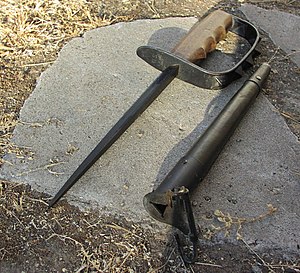
Back Grabendolch German Cuchillo de trinchera Spanish Pugnale da trincea Italian トレンチナイフ Japanese Faca de trincheira Portuguese Траншейный нож Russian Окопний ніж Ukrainian

A trench knife is a combat knife designed to kill or incapacitate an enemy at close quarters, such as in a trench or other confined area.[1][2][3] It was developed as a close combat weapon for soldiers attacking enemy trenches during the First World War. An example of a World War I trench knife is the German Army's Nahkampfmesser (close combat knife).[4][5]
During the Second World War, the trench knife, by this time also called a combat knife, was developed into new designs. On the German side, the Nahkampfmesser and associated knives were widely issued to the ordinary soldier for combat and utility purposes, while Allied armies mostly issued trench knives to elite infantry units and soldiers not equipped with the bayonet.[4]
- ^ Peterson, Harold L., Daggers and Fighting Knives of the Western World, Courier Dover Publications, ISBN 0-486-41743-3, ISBN 978-0-486-41743-1 (2001), p. 80: "Right at the outset trench knives were introduced by both sides during World War I, so that the common soldier was once again equipped with a knife designed primarily for combat."
- ^ Alger, John I., Definitions and Doctrine of the Military Art: Past and Present, Avery Publications Group, ISBN 0-89529-309-9, ISBN 978-0-89529-309-1 (1985), p. 102
- ^ Catalog of Standard Ordnance Items, Washington, D.C: U.S. Army Ordnance Publications (1943)
- ^ a b Bull, Stephen, Encyclopedia of Military Technology and Innovation, Greenwood Publishing, ISBN 1-57356-557-1 (2004), p. 70: During World War I, many German trench or close-combat knives (Nahkampfmesser) were issued by the military, while privately purchased knives were often made to military patterns. Most featured blades of around 150 mm (6 inches), with slab wooden grips and metal scabbards.
- ^ Military Collectables: An International Directory of Twentieth-Century Militaria, Crescent Books, ISBN 0-517-41266-7, ISBN 978-0-517-41266-4 (1984), p. 37